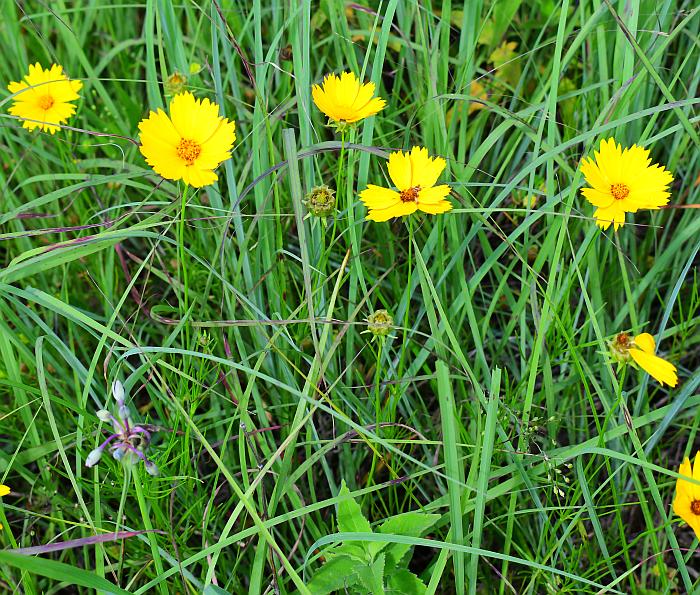Coreopsis grandiflora Hogg ex Sweet
Bigflower Coreopsis

Native
CC = 6
CW = 5
MOC = 31
© SRTurner
Coreopsis grandiflora Hogg ex SweetBigflower Coreopsis | |
 |
Native CC = 6 CW = 5 MOC = 31 |
© SRTurner |
|
Family - Asteraceae/Heliantheae Habit - Perennial forb, with a short, branched rootstock. Stems - Ascending to erect, to 1 m, glabrous.
Leaves - Opposite, distributed at 5-10 nodes along about 2/3 of the length of the stems, sessile or short- or long-petiolate. Blades 3-9 cm long, narrowly oblanceolate or narrowly elliptic (in undivided leaves) to oblong-ovate or broadly ovate (in divided leaves), those of the basal and lowermost stem leaves sometimes unlobed, but those of most leaves 1 or 2 times deeply pinnately or palmately divided into 5-9 slender, narrowly linear to narrowly lanceolate lobes or divisions, in entire leaves the blade angled or tapered at the base; in divided leaves the lobes 0.5-3.0 mm wide, narrowly linear to narrowly oblong-lanceolate, angled or tapered at the base, rounded or more commonly angled or tapered to a usually sharply pointed tip, glabrous or the margins sometimes with a few spreading hairs at the leaf base.
Inflorescence - Solitary terminal heads, or loose, open clusters of heads, the stalks 8-20 cm long. Heads - Radiate, showy. Involucre cup shaped, the bracts dimorphic, the outer series 4-10 mm long; the inner series 7-12 mm long. Receptacle flat or slightly convex. Chaffy bracts narrowly triangular, long-tapered from an abruptly broadened, flat basal portion to a sharply pointed tip.
Ray flowers - Usually 8, sterile, the corolla 12-25 mm long, with 3-5 deep, sometimes irregular, jagged teeth or lobes around the tip, uniformly yellow to orangish yellow. Disk flowers - Perfect, 40-80 per head, the corollas 3.5-5.0 mm long, 5-lobed, yellow, sometimes with yellowish orange lobes. Style branches tapered abruptly to a sharply pointed, sterile tip. Pappus of 1 or 2 scalelike teeth 0.1-0.3 mm long.
Fruits - Achenes 2.0-3.5 mm long, the base and tip appearing curled or arched inward at maturity, the angles with broad, pale wings having entire or occasionally slightly irregular margins, the inner face with a bulbous thickening at 1 or both ends, dark brown to black, 1 or both surfaces smooth to minutely pebbled, sometimes with small, lighter-colored tubercles, especially on the inner surface. Flowering - April - July. Habitat - Prairies, glades, bluffs, forest openings, roadsides. Origin - Native to the U.S. Lookalikes - Other species of Coreopsis; more broadly, some species of Bidens, Helianthus, etc. Other info. - This species is found predominantly in the southwestern quarter of Missouri, with additional populations in the southeast part of the state. Its main U.S. distribution is within Missouri, Kansas, Oklahoma, and Arkansas. It is easily recognized by its showy flowers, highly dissected leaves with threadlike ultimate segments, and prairie habitat. Like all members of the Coreopsis genus, it has involucral bracts of two very distinct forms, which can be clearly seen in the images above. Photographs taken at Dave Rock Conservation Area, St. Claire County, MO., 6-7-03 and 6-16-05, and at the Lonesome Prairie Conservation Area, Benton County, MO., 5-15-04 (DETenaglia); also at Tingler Prairie Natural Area, Howell County, MO, 6-10-2021 (SRTurner). |